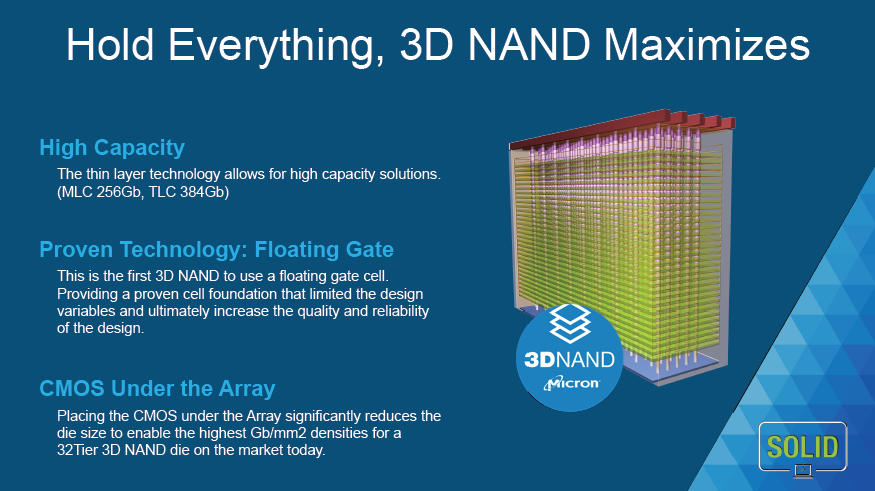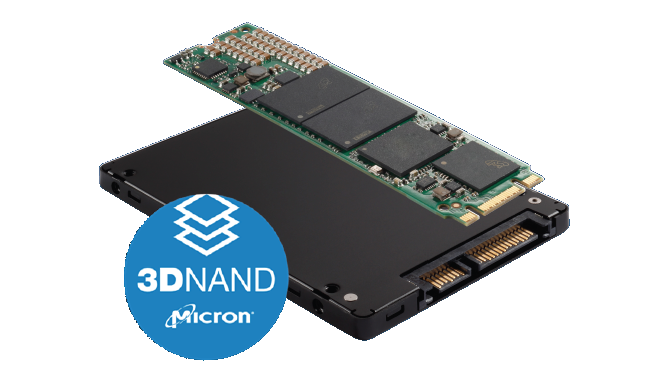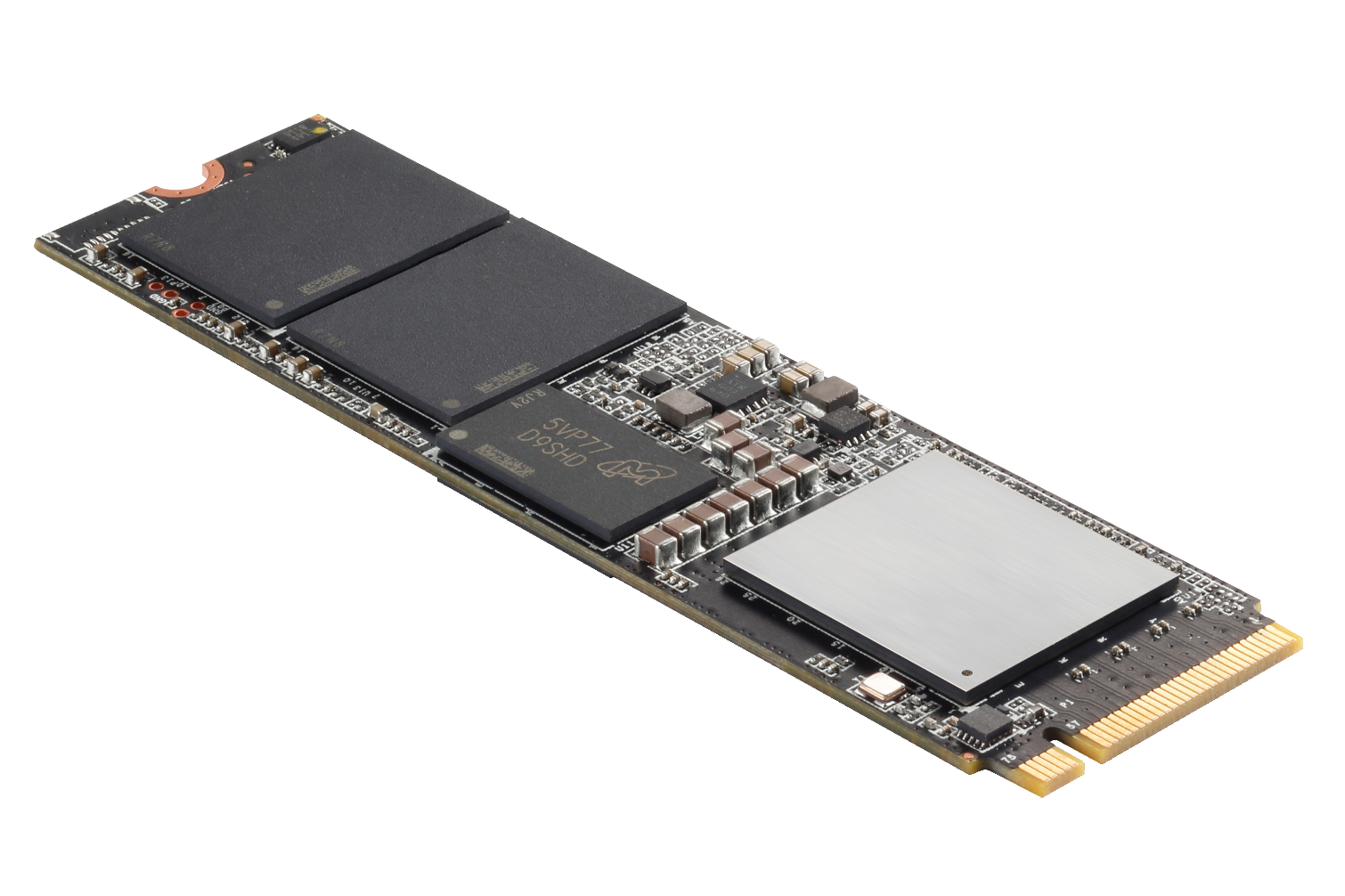Micron Announces SATA And NVMe SSDs With 3D For Client Market
Micron just announced two client SSDs for the system integrator and OEM builder markets. Both products utilize new 3D flash to increase performance, capacity and endurance over existing products. The new Micron 1100 series extends the SATA portfolio to 2 TB of capacity in a single slim 2.5-inch form factor. The 2100 series ushers in Micron's first client NVMe SSD to supercharge storage performance for gaming and professional application workloads.
Most new products from Micron, and its consumer brand, Crucial, will be powered by new 3D NAND flash that doubles (MLC) and triples (TLC) die density. Micron has stated that 3D will not move existing planar (2D) flash to end-of-life status anytime soon. The two technologies will coexist, at least for most of 2017. It will be interesting to see how that happens when 3D yields improve.
At this time, Micron has 3D flash in two flavors. The multi-level cell (MLC) parts ship in 256 Gbit die density, twice as large as existing 16nm 2D MLC and TLC flash shipping today. The triple-level cell (TLC) 3D increases the die density 3x, up to 384 Gbit. As yields improve and manufacturing transitions over, the cost of 3D will achieve parity with planar NAND. There is a large investment in research and development that needs to be recouped, though.
3D NAND offers many benefits over existing planar flash. The endurance resets back to at least 2010 levels, which allows more data to write to the cells before they expire. Micron's 3D implementation operates with less power than the technology it will soon succeed. Finally, we have the density factor that we've already discussed.
Micron 1100 2.5-inch and M.2 SATA SSD
The Micron 1100 is the first client SSD to utilize 3D TLC flash from the company. This product is similar to the Crucial MX300 we spotted on Amazon last month. Both utilize the Marvell Dean 4-channel controller, but what makes the 1100 unique is the additional M.2 form factor and official capacity size information. Until now, we've seen the MX300 only in 750 GB capacity, but the new 1100 will ship in standard 256 GB, 512 GB, 1 TB and a massive 2 TB.
Micron included several advanced features such as Data Path Protection, Power Loss Protection (for data at rest), Adaptive Thermal Monitoring, RAID, Dynamic Write Acceleration, and TCG Opal Encryption. The drives also support Garbage Collection and S.M.A.R.T.
| Product | 1100 256 GB | 1100 512 GB | 1100 1TB | 1100 2 TB |
|---|---|---|---|---|
| Interface | SATA 6Gbps | SATA 6Gbps | SATA 6Gbps | SATA 6Gbps |
| Sequential Read | 530 MB/s | 530 MB/s | 530 MB/s | 530 MB/s |
| Sequential Write | 500 MB/s | 500 MB/s | 500 MB/s | 500 MB/s |
| Random Read | 55,000 IOPS | 92,000 IOPS | 92,000 IOPS | 92,000 IOPS |
| Random Write | 83,000 IOPS | 83,000 IOPS | 83,000 IOPS | 83,000 IOPS |
| Endurance | 120 TBW | 240 TBW | 400 TBW | 400 TBW |
| MTBF (Million Hours) | 1.5 | 1.5 | 1.5 | 1.5 |
| DEVSLP | 2 mW | 2 mW | 4 mW | 25 mW |
The 1100 series will also ship in an industry-standard M.2 2280 form factor while still running over a SATA 6 Gbps bus. Micron confirmed the M.2 SSD will reach only 1 TB, stopping short of the 2 TB capacity mark found in the 2.5-inch version. The only existing image of the M.2 1100 (above) shows three rows of power capacitors that work to ensure data during a host power loss event. The 1100 will be the first client M.2 SSD to take a proactive approach to data integrity with power capacitors.
Get Tom's Hardware's best news and in-depth reviews, straight to your inbox.
Micron 2100 PCIe 3.0 x4 NVMe SSD
Micron is trying to be coy with the new 2100 high-performance NVMe SSD. Only a single page appeared about this product in the press materials, but that doesn't bind us from releasing more details. This product also utilizes the M.2 2280 form factor, but instead of legacy SATA, it steps up to PCIe 3.0 x4. The interface allows for up to 32 Gbps of bandwidth, right around 8 GB/s. Don't expect that level of performance, though; the PCI-SIG gave this interface room to grow.
We've learned the 2100 uses Silicon Motion's SM2260 controller that we talked about at Computex and Flash Memory Summit last year. The Silicon Motion, Inc reference design (that looks identical to the image above) rates at 2,200 MB/s sequential read and 1,100 MB/s sequential write. Random performance is said to be 200,000 IOPS read and 125,000 IOPS write. It's important to remember that the performance data comes from Silicon Motion and dates back to August 2015.
Micron told us that the SM2260 is an exclusive controller for the company, similar to the SM2258 that Intel procured for the SSD 540s and 5400s series products. Like the 2258, the exclusivity will end at a later date. This is both a significant design win for Silicon Motion and an effective way for Micron to gain access to client-level NVMe technology without a large, upfront R&D investment.
MORE: Best SSDs For The MoneyMORE: Latest Storage News
MORE: Storage in the Forums
Chris Ramseyer is a Contributing Editor for Tom's Hardware, covering Storage. Follow him on Twitter and Facebook.

Chris Ramseyer was a senior contributing editor for Tom's Hardware. He tested and reviewed consumer storage.
-
CaedenV So happy to see so many large m.2 drives entering the market. I am still a year or two off from doing a complete rebuild of my system, but would LOVE to have an 'affordable' 1-2TB m.2 SSD in it for the system drive. Really hoping to see 2TB m.2 well under $0.3/GB in that time.Reply -
vern72 Reply18047900 said:So happy to see so many large m.2 drives entering the market.
The larger capacity M.2 drives are great. Seeing more NVMe drives is even better!
-
stevenrix If people knew how garbage collectors work on an SSD or mechanical drive, they would start yelling at the technology. I am glad to see a bigger M.2 format of 1 Tb on the market, since Samsung has been procrastinating into this segment.Reply


